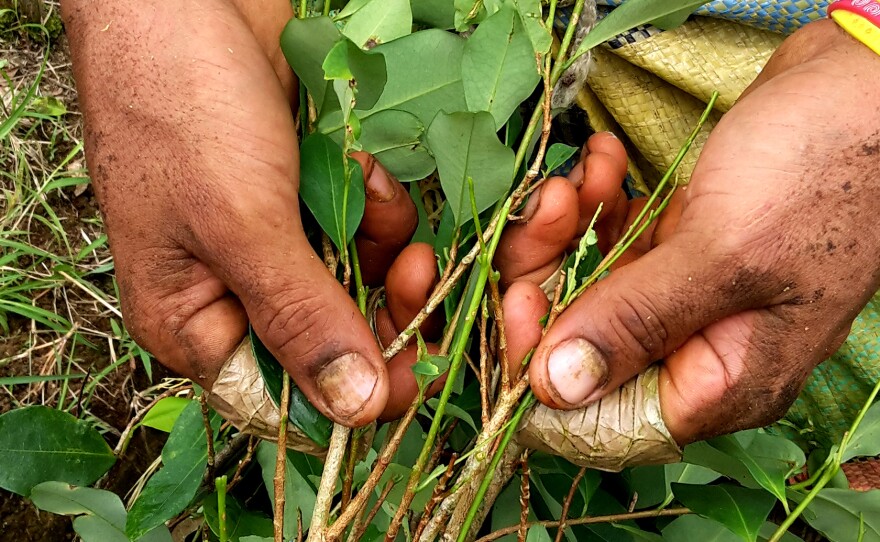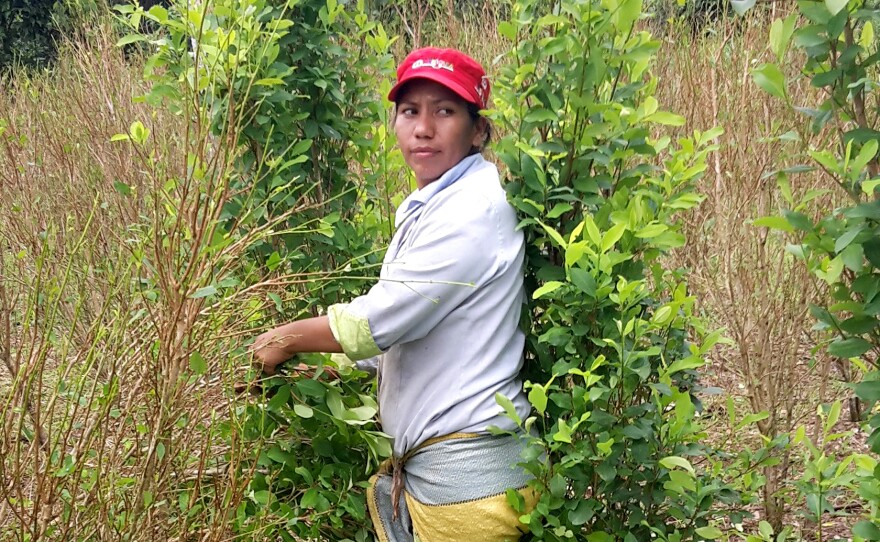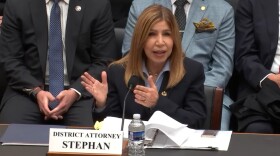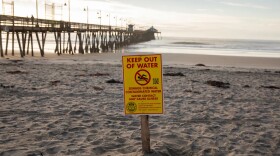

It's harvest time in the coca fields of southern Colombia. Using his bare hands, Franklin Canacuan expertly strips the bright green leaves from his 5-foot-tall coca bushes.
But over the years, Colombian police planes have sprayed his fields with a powerful weed killer.
It's part of a government program to destroy coca leaves, which are used to make cocaine. Since it began in 1994, the program has received more than $2 billion in U.S. funding.
Now, due to health concerns, the Colombian government has decided to ground the spray planes.
Canacuan, the coca farmer, says his 8-year-old daughter became ill briefly after being doused by the rain of defoliant while playing outside.
"It makes people sick. It gives them a fever and skin rashes on their arms." he tells me. "It happens right after the planes pass over."
It's impossible to verify Canacuan's claims. However, misgivings about glyphosate, the active ingredient in the herbicide used to kill coca, are growing.
Daniel Mejia directs the Drug and Security Research Center in Bogota. He conducted a four-year study of coca-growing regions and found that such health problems increased immediately after these areas were fumigated.
"In our own study we find that exposure to glyphosate used in the spraying campaigns in Colombia causes respiratory, dermatological problems and miscarriages," he says.
The Word Health Organization has raised an even bigger red flag. In March, its cancer research arm concluded that glyphosate "is probably carcinogenic to humans."
That prompted the Colombian government on Thursday to order a phasing out of the program. Justice Minister Yesid Reyes said the crop-dusting flights will probably end by October.
Still, it's an awkward time for Colombia to holster a key weapon in its war on drugs.
"For first time in more than eight years, the United States government concluded that coca cultivation and cocaine production in Colombia has increased and increased rather dramatically," says William Brownfield, the U.S. State Department's top anti-drug official.
Colombia's coca crop expanded by 39 percent last year, he says. That means cocaine production may have jumped from 185 tons to 245 tons. Brownfield said a more aggressive spray campaign might have reduced those numbers.
The program is dear to the hearts of U.S. officials because they helped invent it. FARC guerrillas control many of the coca fields and frequently attack ground-based eradication teams. So Colombia opted for aerial eradication with American crop-dusters and glyphosate, which is used by agro-industry all across the globe.
"To the best of our knowledge there is not one single verified case of cancer being caused by glyphosate," Brownfield says.
Monsanto, which manufactures of glyphosate, points to many scientific studies showing that the herbicide poses no risk to humans. It claims that the World Health Organization report ignored this research.
As it turns out, coca farmers routinely handle toxic chemicals. Near the town of La Hormiga, I meet Sandra Trejo, a former coca farmer who has switched to growing black pepper. She got out of the drug trade, in part, because turning coca leaves into cocaine requires mixing powerful solvents, like acetone and sulfuric acid.
"People use very strong chemicals without protection, like goggles, overalls or facemasks," Trejo says. "So we can't blame all the problems on glyphosate."
But Colombian President Juan Manuel Santos says there are other reasons for scrapping the spray program. He says that going after big-time smugglers rather than peasant coca farmers can be a more effective way to fight drugs.
Copyright 2015 NPR. To see more, visit http://www.npr.org/.






